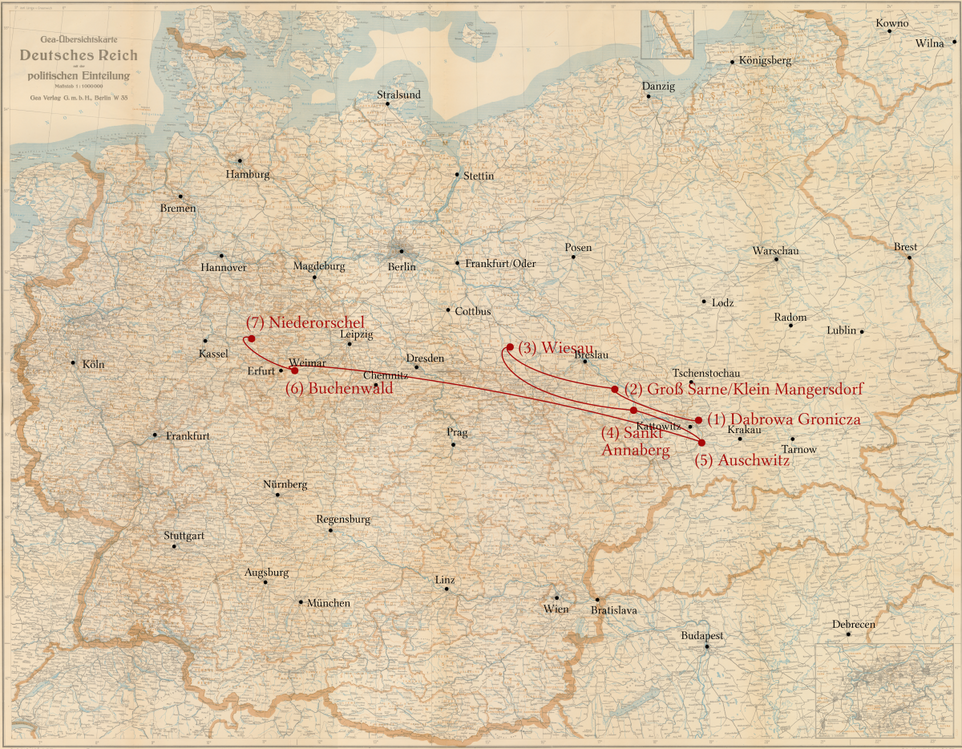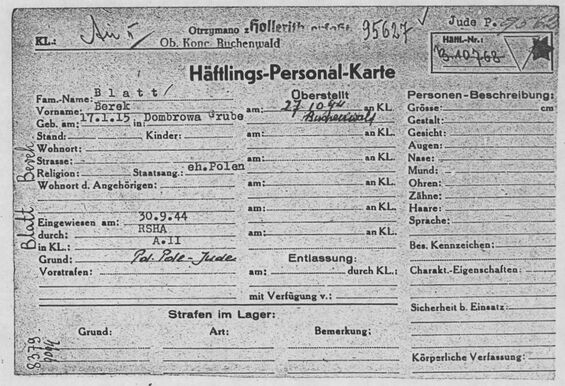The Biography of Berek Blatt, Radom
Short biography and stations of his persecution
- born on 17 January 1915 in Dabrowa Gornicza, died on 25 September 1987
- October 1940 forced labor camp Klein Mangersdorf (Reichsautobahn), forced labor camp Großsarne (bridge construction) ,
- End of 1942 to end of 1943 forced labor camp Wiesau (construction work, accident),
- End of 1943 to 9/1944 forced labor camp Annaberg (various works, river regulation),
- 30.9.1944 Auschwitz concentration camp, number B 10768
- 19 November 1944 to 1 April 1945 Buchenwald concentration camp / Niederorschel subcamp (aircraft construction)
- 10 April 1945 to 11 April 1945 Buchenwald concentration camp
- 1945 to 1946 Heidenheim
- 1946 to 1948 Bamberg
- 1948 Fürth
- 1949 USA
Berek Blatt lost his parents and two brothers to persecution. He was 25 years old when his persecution began.
Before the war
I am making this affidavit in connection with my application for compensation for damage to body and health. Before the outbreak of the Second World War, I lived with my parents and siblings in Dombrowa, the town where I was born. I was in excellent health and cannot remember any serious illnesses. After finishing school, I worked as a clerk for a while and later as a locksmith. My ordeal began with the outbreak of persecution.
Source: Affidavit
Klein Mangersdorf (Magnuszowiczki)
In October 1940, I was arrested, separated from my family and transferred to the Kleinmangersdorf forced labor camp. There I was made to do hard forced labor for a while building the Reichsautobahn. As I was not used to the hard work and it was far beyond my strength, I suffered terribly from a back injury while unloading a wagon. The sentries drove us to work faster and faster. In winter we had totally inadequate protection against the cold and I suffered constantly from feverish chills for which I received no medical help. At times we were given nothing to eat at all. We also had harassing roll calls. When I once asked to be allowed to leave during a roll call, I was brutally beaten.
Source: Affidavit
| Forced labor camps for Jews in Silesia | |
|---|---|
| Place | Little Mangersdorf (Magnuszowiczki) |
| Area | Prussia (Province of Upper Silesia) |
| Opening | 29.03.1940 |
| Closing | June 1944 (last mention) |
| Gender | Male |
| Employment of the prisoners at | Company Julius Schallhorn, Berlin |
| Type of work | Work on the Reichsautobahn |
| Source: deutschland-ein-denkmal.de | |
Groß Sarne, Wiesau
Then I was taken to the Grossarne forced labor camp. The living conditions were the same. I was put to work building bridges. I was often beaten. Our food consisted of a starvation ration. Again, I suffered from frequent colds. In December 1942, I was transported to the Wiesau forced labor camp. Again I had to do heavy construction work. I had a serious accident in this camp. An iron girder fell on my left leg. I suffered a complicated fracture and had to stay in the infirmary for 5-6 months. There was almost nothing to eat during this time. I suffered terrible pain. If I hadn't been helped by a medic who took pity on me, I probably wouldn't have survived.
Source: Affidavit
| Forced labor camps for Jews in Silesia | |
|---|---|
| Location | Sarny Wielkie / Greater Sarne |
| Area | Prussia (Province of Upper Silesia) |
| Opening | 10.02.1940 (first mention) |
| Closing | September 1943 (last mention) |
| Gender | Male |
| Employment of the prisoners at | Wayss u. Freytag; Grün u. Bilfinger AG; Quecke u. Schramm; Lentz company; Plüschke company; Julius Schallhorn company, Berlin |
| Type of work | Work on the Reichsautobahn |
| Source: deutschland-ein-denkmal.de | |
| Forced labor camps for Jews in Silesia | |
|---|---|
| Place | Wiesau |
| Area | Prussia (Province of Lower Silesia) |
| Opening | April 1941 |
| Closing | July 1944 |
| Deportations | The prisoners were "transferred" to concentration camp Groß Rosen/"Kommando Bunzlau", the sick to Auschwitz |
| Prisoners gender | Men |
| Employment of the prisoners at | Berg- und Hütten AG; Kemna-Lenz company; Vetter u. Weder; Glatzer Bau-Ring company; Heinke company; Humboldt company; Jeche company |
| Type of work | Copper smelter construction, work on the Reichsautobahn, construction work |
| Source: deutschland-ein-denkmal.de | |
Landeshut and Annaberg
I was then sent to the Landeshut forced labor camp, where the same conditions prevailed and I had to work hard again. From there I was dragged to the forced labor camp in Annaberg. My health deteriorated more and more. Nevertheless, I was put to the most strenuous forced labor. I had to do a wide variety of work inside and outside the camp.
Source: Affidavit
September 1944 to November 1944 Auschwitz concentration camp
I finally arrived in Auschwitz in September 1944. When I arrived at this extermination camp, I was branded with the number B 10768. I was kept in the quarantine. I was harassed and beaten. They even set dogs on me. I was not allowed to work.
Source: Affidavit
Niederorschel and Buchenwald
In November 1944, I was loaded onto a cattle train and taken on a two-day journey to Buchenwald Kommando Niederorschel. I was almost unable to stand on my feet, but was mercilessly forced to continue working in aircraft construction. I also had to do plumbing work. Shortly before liberation, I was driven on an extermination march. We had to walk about 90 km. Anyone who could no longer walk was shot. When we arrived at Buchenwald main camp, I was completely exhausted. The plan was to shoot all the survivors during a roll call. Before this plan could be carried out, we were liberated at the last minute by the US Army. At that time I was completely broken physically and mentally and immediately went for medical treatment.
Source: Affidavit
..
| Subcamps of the Buchenwald concentration camp | |
|---|---|
| Location | Lower Orschel |
| Area | Prussia (Province of Saxony) |
| Opening | 04.09.1944 (first mention) |
| Closing | "Evacuation" on 01.04.1945 to Buchenwald, arrived there on 10.04.1945 |
| Inmates | Average of 430, including numerous Jews |
| Gender | Men |
| Employment of the prisoners at | Langenwerke AG, Niederorschel, which was located on the grounds of the Junkerswerke |
| Type of work | Work in the plywood factory |
| Comments | The prisoners' accommodation was located in a nearby weaving hall, which was connected to the plywood factory by a barbed wire fence |
| Source: deutschland-ein-denkmal.de | |
After the war
Shortly after the liberation, I found out that my parents and two of my brothers had been killed by the Nazis. That was another shock for me. I stayed in West German DP camps until 1949 and then emigrated to the USA.
Source: Affidavit
Notes
further Sources
- Niederorschel: Encyclopedia of CAMPS AND GHETTOS, 1933–1945. VOLUME I. Early Camps, Youth Camps, and Concentration Camps and Subcamps under the SS-Business Administration Main Office (WVHA), Part A Indiana University Press 2009 S.400
Compensation office
Stuttgart, 1965, ES 2598(0)-I-Sp
Notes
- For Berek Blatt, see Landesarchiv Baden-Württemberg/Staatsarchiv Ludwigsburg
- For the post-war fate of Berek Blatt, see the relevant post-war documents at Arolsen Archives.
Photo Credits
- Arbeitseinsatzkarte Buchenwald; Quelle: 1.1.5.3/5552894/ITS Digital Archive, Arolsen Archives
- Häftlings-Personal-Karte Buchenwald; Quelle:1.1.5.3/5552896/ITS Digital Archive, Arolsen Archives


